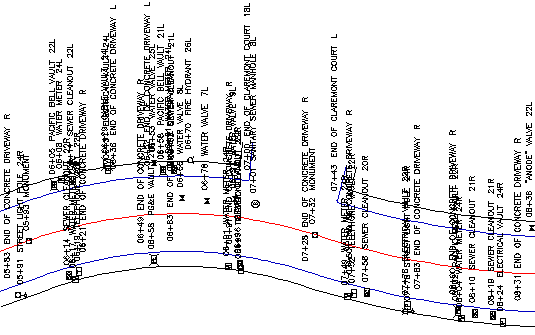Also included in MapTools Pro
Our Attribute Arrangement tool is a multi-purpose function for rearranging attributes associated with Blocks and Reordering groups of attributes in “Station Order”. It can be called as a command line function or it can be included as a part of a batch operation. When called from the command line, a dialog box menu is presented for selection of the operating parameters. When called as a part of a Batch Operation, a subset of the command line options are available.
Blocks used in corridor mapping applications tend to use many attributes. We will use a typical municipal utility map to demonstrate the uses of our Attribute Arrangement tool.

When the map is first constructed, we will have attribute blocks to represent each mapped feature, such as utility features, survey features and road features. These blocks will have default locations for each attribute so when we have a lot of them, they will tend to overlap.
Attribute Order
Attributes that are associated with a Block will be arranged in a specific order controlled by a special definition. This definition actually includes two definitions per Block, one for the “left” side and one for the “right” side. These definitions can be reviewed and modified by pressing the View / Edit Definitions Button which will display a special Dialog Box for this purpose.
Arrangement Modes – Group Start Points
We offer 4 Group Start Point modes (this determines where the attribute group will be located).
The Fixed option will use the location of the closest attribute (to the block insertion point) as the group start point. The remaining attributes will then be moved according to the rearrange definition.
The Rearrange option will allow you to draw a line to define to locations of the group start points. The Block with the smallest Station value will be arranged where you pick first and succeeding attributes will be spaced along the line you specified, separated by a distance set by the Rearrange Line Spacing option.
The Offset option has several sub-options. When you specify Offset An Amount, the group start point is calculated from the block insertion point, a distance specified by you and at the same angle as the attributes. In this example, we use Offset by 50 feet. You can also choose to Offset to a Plane. This will line up all group start points along a horizontal or vertical line, still in line with the block insertion point.
Using both sides of the Corridor
As we discussed above, you can specify two different attribute arrangement orders – one for each side of the corridor. Here’s our example using both sides of the street with Offset an Amount and Offset to a Plane.
Automatic – the newest Arrange Option
Using combinations of Offset and Rearrange modes, you can accomplish virtually any attribute display goal but in many circumstances a more automated solution can save lots of time. After using this Attribute Arrangement tool in a production environment for 1000’s of hours, we decided to encapsulate the most ideal solutions into an Auto Arrange Mode. This arrange process actually can operate in two ways – Column and Baseline Follow. The rules are the same for both, find a location along a given path where a group of attributes can be displayed without overlapping any other attribute group and be as close as possible to the block insertion point.
If you choose the Baseline Follow option, you will be asked to pick a baseline polyline and move it to a new location. The attributes will then be arranged along that path, according to the rules. If you choose Column mode you will be asked to pick a location. Attributes will be lined up along a horizontal or vertical line (depending on the angle of the attributes) passing through that point. Another use of this mode would involve setting the “side definition” to create a different Column arrangement.
A New Leader Option
The Arrange Attribute tool in CoriMap includes a new leader option. If enable, a line will be drawn between the block insertion point and the attribute group start point. You can use this option with any mode – here an example of Auto mode Baseline Follow with Leaders and Auto mode Column with Leaders.
Attribute Stacking
Sometimes attributes contain more information that can be fit in a given area. Our answer to this is Attribute Stacking. You can specify any number of attributes to be stacked. You can then turn on stacking Above (displays the stacked attributes above the non-stacked attributes) or Below.

